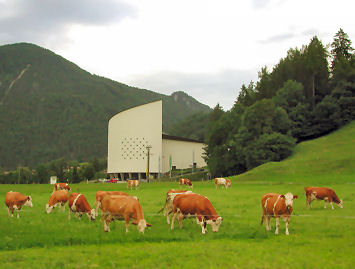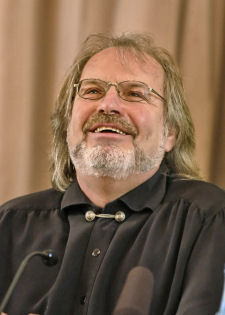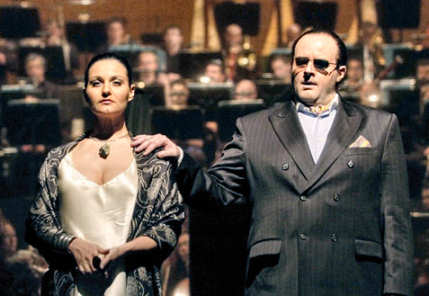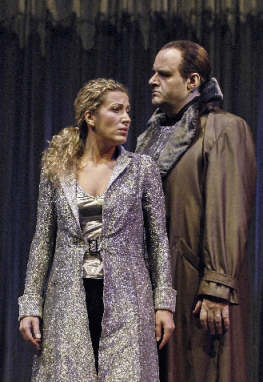|
Editor: Marc Bridle
Webmaster: Len Mullenger
|
Seen and Heard International
Opera Review
The Erl Passionsspielhaus The 1500 seat Passionsspielhaus in the tiny Austrian village of Erl is an unlikely place for Wagnerian World Records (this was the world's first '24 Hour Ring' ) or for triumphant Ring cycles in general. Set in its own 'Grünen Hügel' however, since 1998 this cramped pit-less theatre has been quietly turning itself into an Austrian 'Bayreuth', thanks to the apparently limitless energy of the polymath musician and producer, Dr. Gustav Kuhn.
Unlike Bayreuth though, the Tirol festival is devoted not only to Wagner but also provides a varied programme of other operas, orchestral music and recitals. It runs annually throughout July and August, except in the years when the village gives its Passion Play, which it has been doing every eight years since 1613 and for which the theatre was built in 1959. It is the Wagner however which attracts the greatest attention, especially since complete Ring cycles were launched in 2003.
Gustav Kuhn
Fifty nine year old Kuhn is a Salzburger who describes himself as passionate motorcyclist, yachtsman and enfant terrible of the contemporary music scene. He studied music from the age of five, won the International Conducting Competition of the Austrian Broadcasting Corporation in 1969 and also completed a Ph.D in philosophy, psychopathology and psychology in 1970. He took conducting courses with Bruno Maderna and von Karajan, founded the 'Institute for Aleatoric Music' in Salzburg in 1974 and, as his international conducting career developed particularly in Italy, he turned to stage direction and producing in 1986.
At about this time too, Kuhn had the idea of promoting a training institution for young musicians and artists which would allow them to develop on their own merits, regardless of the pressures they face from modern day business interests. This notion became fully realised in 1992, with the foundation of Kuhn's Accademia di Montegral, based near Lucca, Tuscany. At the Accademia, young singers, instrumentalists, composers and designers receive expert tuition and guidance from the institution's many expert members, all established artists in their own fields. No wonder then, that this week Austrian television described Kuhn as the ' Ironman of Culture.'
The Tirol Festival was launched partly to provide performance opportunties for people attending the Accademia and partly to provide what Kuhn describes as 'a confrontation between new and classical music.' It was based in Erl for four reasons: the village is within easy access of both Munich and Innsbruck, it has an available (though less than ideal) theatre in a popular tourist area and the nearby town of Kufstein has a variety of useful concert venues. Most importantly however, the village has a longstanding tradition of active community participation in artistic events (surely resonant with some of Wagner's ideals) from which the notion of performing the Ring could properly flourish. While the aim from the outset was always to give complete cycles, the festival (like so many international opera houses these days) started by offering one production at a time until 2003. As both confidence and reputation developed however, the never to be repeated notion of the 24 Hour Ring simply grew like Topsy from Uncle Tom's Cabin. ' Wagner is a kind of addiction,' Kuhn said half-jokingly in a recent press interview, 'Somehow, we always want more.'
Die Walküre Act III - 2004
The arrangement of the Passionsspielhaus requires the orchestra and conductor to be behind the singers, who play out the drama from a very small stage using limited sets and props. The orchestra sits inside an acoustic tent (used effectively throughout as part of the lighting plot) and a vertical mesh screen separates it from the singers. While cueing and tempi can be managed reasonably well enough using closed-circuit television, relative dynamics are quite a different matter. It is a tribute to all concerned that there were few instances indeed where voices (or solo instrumentalists playing from within the audience on occasions) were swamped by orchestral sound, and a fine sense of balance was preserved throughout.
Das Rheingold : Martina Tomcic (Fricka) and Duccio Dal Monte (Wotan)
As Stage Director / Producer, Kuhn uses a modern
dress setting with the resultant anachronisms. The gods are a
set of cocktail drinking hedonists, with Donner as a competitive
hammer-thrower and Froh rigged out in golfing gear. The Giants
are baseball and ice-hockey players respectively and Loge is a
nattily suited fixer with a mobile phone. At no point does Wotan
wield his spear; instead something like a modern javelin hangs
above the stage - and in Die Walküre, Hunding (some
kind of TV - loving, motor cycling traffic cop) shoots the sword-bearing
Siegmund with his pistol. The Valkyries themselves are Rude Girl
Mountain Bikers with severed body-parts strapped to their handlebars,
all except for Brünnhilde, whose hard hat, jodhpurs and riding
crop suggest that one of the local Haflinger horses might be somewhere
in the offing.
What does work unequivocally however is Kuhn's use of the available space. Every inch of the auditorium is put to some purpose: the Nibelungs play their anvils from the side aisles, and then run through the whole hall when terrified by Alberich. Characters often enter from behind the audience, Siegfried's boat is carried down the centre aisle by the firemen, and horn players pop up in the audience. This, particularly the involvement of the firemen and lots of local schoolchildren makes for exciting theatre.
The Valkyries and Wotan (Duccio Dal Monte)
It has always been an Erl tradition to use multiple soloists for the principal roles at different points in the cycle - so different singers will play Wotan and The Wanderer for example. Surprisingly though this principle was not noticeably extended for this marathon event and the only exception was to have different Siegfrieds, Jürgen Müller (a robust exponent of the Forging Song) and then Gianluca Zampieri in Götterdämmerung.
As might be imagined a distinct sense of nervousness was detectable everywhere before the performance began and it was clear that during Das Rheingold, some of the artists who would be appearing again the next day were taking care to ensure they would last the course. This was particularly noticeable from Martina Tomcic (Fricka) from Thomas Gazheli (Alberich, The Wanderer) and Michael Kupfer (Donner, Gunther) all of whom gave the definite but understandable impression that they were holding back somewhat. At this point too even the indefatigable Dr. Kuhn and his orchestra seemed fairly reticent: there was some very dubious ensemble during the prelude and the huge chord expected after Donner's hammer blow was distinctly muted as was the music for the gods' entry to Valhalla. Redeeming performances were given however by Italian bass Duccio Dal Monte (a seasoned Erl Wotan) by Susan Gebb (Freya) by Xiaoliang Li (Fasolt ) and by Roy Stevens (an American baritone, lately turned heldentenor) as Loge. One down then, so to speak, and three more to go in the next twenty four hours.
Elena Comotti D'Adda (Brünnhilde) and Duccio Dal Monte (Wotan)
As the audience reassembled for Die Walküre and Siegfried (armed with sandwiches, sustaining drinks and cushions - the seats in the hall are hard and we would be there for eleven hours) excited anticipation was everywhere. Could it actually work? Would Kuhn, his singers and orchestra survive? Would we survive, for that matter? These questions were in the air in a great variety of languages and while every possible preparation had been made by the management (even sun loungers were available for the weary outside the hall, although these were quickly bagged by the Germans) this was the Big One. But would anyone return for Götterdämmerung the next morning? Were we in for the worst Ring ever and could it possibly be worth the effort of finding out?
We weren't, it was worthwhile, and we did return after five hours sleep because this was a magnificent event, providing an intensity of experience (and even a grandeur) that would be difficult to surpass. As in all Ring performances of course, some singers were better than others, some voices more suited to Wagner and others less so. But from the prelude of Die Walküre through to the end of Götterdämmerung it was hard not to be enthralled even during the dog- watch hours of Siegfried.
Some particular highlights were Dal Monte's Wotan (firm, assured and controlled bass singing) Martina Tomcic's Fricka in Die Walküre (a confident more resonant mezzo than in Rheingold) Gertrud Ottenthal's touching Sieglinde, Monicka Wäckerle's Waltraute, both of the Siegfrieds (different kinds of voice and interpretations but good singing from each, with the edge perhaps from Zampieri.) Sabine Turner's Gutrune was sung with great assurance and she acted decadent seductiveness towards all the men in her life very effectively. Michael Kupfer made an exellent Gunther (far better than his Donner) and Peter Loehle's Hagen was as menacing as they come. Of the two Brünnhildes, Elisabeth Wachutka (in Siegfried) was perhaps the stronger singer, but the diminutive Elena Comotti D'Adda was fine too, showing only occasional signs of strain and uncontrolled vibrato.
As much as anything however, it was Kuhn's direction of his huge orchestral forces and the wonderful chorus work in Götterdämmerung that will be the abiding memories. There are no plans, so far as I know to repeat the event and the second Tirol Festival cycle this year will be given over a more normal four days. Perhaps there should be a repeat at some point though, since the 'Ironman of Culture's' gamble paid off so handsomely. I might even go again, if my old bones can manage the seating.
Pictures from the 2004 production © Rupert Larl
Full details of the remaining performances for the Tirol Festival
2005 are available at http://www.tiroler-festspiele.at/
Back to the Top Back to the Index Page |
| ||
|
||||








